Archive
Why buy a Vampire accelerator?
With the Amiga about to re-enter the consumer market, a lot of us “old timers” are busy knocking dust of our old machines. And I love my old machines even though they are technically useless by modern standards. But these machines have a lot of inspiration in them, especially if you write code. And yes there is a fair bit of nostalgia involved in this, there is no point in lying about any of this.
I mean, your mobile phone is probably 100 times faster than a vintage Amiga. But like you will discover with the new machines that are about to hit the market, there is more to this computer than you think. But vintage Amiga? Sadly they lack the power to anything useful [in the “modern” sense].
Enter the vampire
The Vampire is a product that started shipping about a year ago. It’s a FPGA based accelerator, and it’s quite frankly turning the retro scene on its head! Technically it’s a board that you just latch onto the CPU socket of your classical Amiga; it then takes over the whole machine and replace the CPU and chipset with its versions of these. Versions that are naturally a hell of a lot faster!
 The result is that the good old Amiga is suddenly beefy enough to play Doom, Quake, MP3 files and MPG video (click here to read the datasheet). In short: this little board gives your old Amiga machine a jolt of new life.
The result is that the good old Amiga is suddenly beefy enough to play Doom, Quake, MP3 files and MPG video (click here to read the datasheet). In short: this little board gives your old Amiga machine a jolt of new life.
Emulation vs. FPGA
Im not going to get into the argument about FPGA not being “real”, because that’s not what FPGA is about. Nor am I negative to classical hardware – because I own a ton of old Amiga gear myself. But I will get in your face when it comes to buying a Vampire.
Before we continue I just want to mention that there are two models of the vampire. There is the add-on board I have just mentioned which is again divided into different models for various Amiga versions (A600, A500 so far). The second model is a completely stand-alone vampire motherboard that wont even need a classic Amiga to work. It will be, for all means and purposes, a stand alone SBC (single board computer) that you just hook up power, video, storage and mouse – and off you go!
This latter version, the stand-alone, is a project I firmly believe in. The old boards have been out of production since 1993 and are getting harder to come by. And just like people they will eventually break down and stop working. There is also price to consider because getting your 20-year-old A500 fixed is not easy. First of all you need a specialist that knows how to fix these old things, and he will also need parts to work with. Since parts are no longer in production and homebrew can only go so far, well – a brand new motherboard that is compatible in every way sounds like a good idea.
There is also the fact that FPGA can reach absurd speeds. It has been mentioned that if the Vampire used a more expensive FPGA modules, 68k based Amiga’s could compete with modern processors (Source: https://www.generationamiga.com/2017/08/06/arria-10-based-vampire-could-reach-600mhz/). Can you imagine a 68k Amiga running side by side with the latest Intel processors? Sounds like a lot of fun if you ask me !
But then there is emulation. Proper emulation, which for Amiga users can only mean one thing: UAE in all its magnificent diversity and incarnations.
Nothing beats firing up a real Amiga, but you know what? It has been greatly exaggerated. I recently bought a sexy A1000 which is the first model that was ever made. This is the original Amiga, made way back before Commodore started to mess around with it. It cost me a small fortune to get – but hey, it was my first ever Amiga so I wanted to own one again.
But does it feel better than my Raspberry PI 3b powered A500? Nope. In fact I have only fired up the A1000 twice since I bought it, because having to wait for disks to load is just tedious (not to mention that you can’t get new, working floppy disks anymore). Seriously. I Love the machine to bits but it’s just damn tedious to work on in 2017. It belongs to the 80s and no-one can ever take away its glory or it’s role in computer history. That achievement stands forever.
High Quality Emulation
If you have followed my blog and Amiga escapades, you know that my PI 3b based Amiga, overclocked to the hilt, yields roughly 3.2 times the speed of an Amiga 4000/040. This was at one point the flagship Commodore computer. The Amiga 4000’s were used in movie production, music production, 3d rendering and heavy-duty computing all over the world. And the 35€ Raspberry PI gives you 3.2 times the power via the UAE4Arm emulator. I don’t care what the vampire does, the PI will give it the beating of its life.

My retrofitted Raspberry PI 3b Amiga. Serious emulation at high speed allowing for software development and even the latest Freepascal 3.x compiler
Then suddenly, out of the blue, Asus comes along with the Tinkerboard. A board that I hated when it first came out (read part-1 here, part-2 here) due to its shabby drivers. The boards have been collecting dust on my office shelf for six months or so – and it was blind luck that i downloaded and tested a new disk image. If you missed that part you can read the full article here.
And I’m glad I did because man – the Tinkerboard makes the Raspberry PI 3b look like a toy! Asus has also adjusted the price lately. It was initially priced at 75€, but in Norway right now it retails for about 620 NKR – or 62€. So yes, it’s about twice the price of the PI – but it also gives you twice the memory, twice the graphics performance, twice the IO performance and a CPU that is a pleasure to work with.
The Raspberry PI 3b can’t be overclocked to the extent the model 1 and 2 could. You can over-volt it and tweak the GPU and memory and make it run faster. But people don’t call that “overclock” in the true sense of the word, because that means the CPU is set to run at speeds beyond the manufacturing specifications. So with the PI 3b there is relatively little you can do to make it run faster. You can speed it up a little bit, but that’s it. The Tinkerboard can be overclocked to the hilt.

The A1222 motherboard is just around the corner [conceptual art]
In short: if you fork out 70€ you get a SBC that runs rings around both the vampire and the Raspberry PI 3b. If we take height for some Linux services and drivers that have to run in the background, 3.2 x 3 = 9.6. Lets round that off to 9 since there will be performance hits by the background services. But still — 70€ for an Amiga that runs 9 times faster than A4000 @ MC68040 cpu ? That should blow your mind!
I’m sorry but there has to be something wrong with you if that doesn’t get your juices flowing. I rarely game on my classic Amiga setup. I’m a coder – but with this kind of firepower you can run some of the biggest and best Amiga titles ever made – and the Tinkerboard wont even break a sweat!
You can’t afford to be a fundamentalist
There are some real nutbags in the Amiga community. I think we all agree that having the real deal is a great experience, but the prices we see these days are borderline insane. I had to fork out around 500€ to get my A1000 shipped from Belgium to Norway. Had tax been added on the original price, I would have looked at something in the 700€ range. Still – 500€ for a 20-year-old computer that can hardly run Workbench 1.2? Unless you add the word “collector” here you are in fact barking mad!
If you are looking to get an Amiga for “old times sakes”, or perhaps you have an A500 and wonder if you should fork out for the Vampire? Will it be worth the 300€ pricetag? Unless you use your Amiga on a daily basis I can’t imagine what you need a vampire for. The stand-alone motherboard I can understand, that is a great idea – but the accelerator? 300€?
I mean you can pay 70€ and get the fastest Amiga that ever existed. Not a bit faster, not something on second place – no – THE FASTEST Amiga that has ever existed. If you think playing MP3 and MPG media files is cool with the vampire, then you are in for a treat here because the same software will work. You can safely download the latest patches and updates to various media players on the classic Amiga, and they will run just fine on UAE4Arm. But this time they will run a hell of a lot faster than the Vampire.
You really can’t be a fundamentalist in 2017 when it comes to vintage computers. And why would you want to? With so much cool stuff happening in the scene, why would you want to limit your Amiga experience to a single model? Aros is doing awesome stuff these days, you have the x5000 out and the A1222 just around the corner. Morphos is stable and good on the G5 PPC — there has never been a time when there were so many options for Amiga enthusiasts! Not even during the golden days between 1989-1994 were there so many exciting developments.
I love the classic Amiga machines. I think the Vampire stand-alone model is fantastic and if they ramp up the fpga to a faster model, they have in fact re-created a viable computer platform. A 68080 fpga based CPU that can go head to head with x86? That is quite an achievement – and I support that whole heartedly.
But having to fork out this amount of cash just to enjoy a modern Amiga experience is a bit silly. You can actually right now go out and buy a $35 Raspberry PI and enjoy far better results than the Vampire is able to deliver. How that can be negative? I have no idea, nor will I ever understand that kind of thinking. How do any of these people expect the Amiga community to grow and get new, young members if the average price of a 20-year-old machine costs 500€? Which incidentally is 50€ more than a brand new A1222 PPC machine capable of running OS 4.
And with the Tinkerboard you can get 9 times the speed of an A4000? How can that not give you goosebumps!
People talk about Java and Virtual-Machines like its black magic. Well UAE gives you a virtual CPU and chipset that makes mince-meat of both Java and C#. It also comes with one of the largest software libraries in the world. I find it inconceivable that no-one sees the potential in that technology beyond game playing – but when you become violent or nasty over hardware, then I guess that explains quite a bit.
I say, use whatever you can to enjoy your Amiga. And if your perfect Amiga is a PI or a Tinkerboard (or ODroid) – who cares!
I for one will not put more money into legacy hardware. I’m happy that I have the A1000, but that’s where it stops for me. I am looking forward to the latest Amiga x5000 PPC and cant wait to get coding on that – but unless the Appollo crew upgrades to a faster FPGA I see little reason to buy anything. I would gladly pay 500 – 1000 € for something that can kick modern computers in the behind. And I imagine a lot of 68k users would be willing to do that as well. But right now PPC is a much better option since it gives you both 68k and the new OS 4 platform in one price. And for affordable Amiga computing, emulation is now of such quality that you wont really notice the difference.
And I love coding 68k assembler on my Amibian emulator setup. There is nothing quite like it 🙂
Where is PowerPC today?
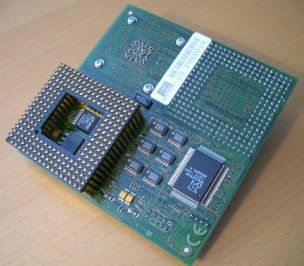
Phase 5 PowerUP board prototype
Anyone who messed around with computers back in the 90s will remember PowerPC. This was the only real alternative for Intel’s complete dominance with the x86 CPU’s and believe me when I say the battle was fierce! Behind the PowerPC you had companies like IBM and Motorola, companies that both had (or have) an axe to grind with Intel. At the time the market was split in half – with Intel controlling the business PC segment – while Motorola and IBM represented the home computer market.
The moment we entered the 1990s it became clear that Intel and Microsoft was not going to stay on their side of the fence so to speak. For Motorola in particular this was a death match in the true sense of the word, because the loss of both Apple and Commodore represented billions in revenue.
What could you buy in 1993?
The early 90’s were bitter-sweet for both Commodore and Apple. Faster and affordable PC’s was already a reality and as a consequence – both Amiga machines and Mac’s were struggling to keep up.
The Amiga 1200 still represented a good buy. It had a massive library of software, both for entertainment and serious work. But it was never really suited for demanding office applications. It did wonders in video and multimedia development, and of course games and entertainment – but the jump in price between A1200 and A4000 became harder and harder to justify. You could get a well equipped Mac with professional tools at that range.
Apple on the other hand was never really an entertainment company. Their primary market was professional graphics, desktop publishing and music production (Photoshop, Pro-tools, Logic etc. were exclusive Mac products). When it came to expansions and ports they were more interested in connecting customers to industrial printers, midi devices and high-volume storage. Mac was always a machine for the upper class, people with money to burn; The Amiga dominated the middle-class. It was a family type computer.
But Apple was not a company in hiding, neither from Commodore or the Wintel threat. So in 1993 they introduced the Macintosh Quadra series to the consumer market. Unlike their other models this was aimed at home users and students, meaning that it was affordable, powerful and could be used for both homework and professional applications. It was a direct threat to upper middle-class that could afford the big box Amiga machines.
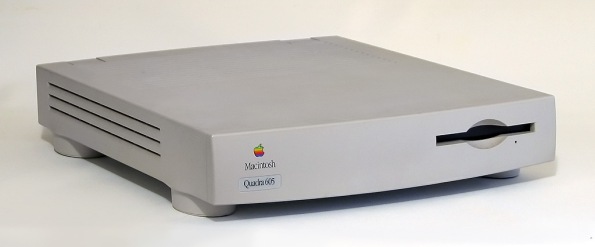
The 68k Macintosh Quadra came out in October of 1993
But no matter how brilliant these machines were, there was no hiding the fact that when it came to raw power – the PC was not taking any prisoners. It was graphically superior in every way and Intel started doubling the CPU speed exponentially year by year; Just like Moore’s law had predicted.
With the 486-DX2 looming on the horizon, it was game over for the old and faithful processors. The Motorola 68k family had been there since the late 70’s, it was practically an institution, but it was facing enemies on all fronts and simply could not stand in the way of evolution.
The PowerPC architecture
If you are in your 20’s you wont remember this, but back in the late 80’s early 90’s, the battle between computer vendors was indeed fierce. You have to take into consideration that Microsoft and Intel did a real number on IBM. Microsoft stabbed IBM in the back and launched Windows as a direct competitor for IBM’s OS2. When I write “stabbed in the back” I mean that literally because Microsoft was initially hired to create parts of OS/2. It was the typical lawsuit mess, not unlike Microsoft and Sun later, where people would pick sides and argue who the culprit really was.
As you can imagine IBM was both bitter and angry at Microsoft for stealing the home PC market in such a shameful way. They were supposed to help IBM and be their ally, but turned out to be their most fierce competitor. IBM had also created a situation where the PC was licensed to everyone (hence the term “ibm clone”) – meaning that any company could create parts for it and there was little IBM could do to control the market like they were used to. They would naturally get revenue from these companies in the form of royalties (and would later retire 99% of all their products. Why work when they get billions for doing nothing?), but at the time they were still in the game.
Motorola was in a bad situation themselves, with the 68k line of processors clearly incapable of facing the much faster x86 CPU’s. Something new had to be created to ensure their market share.
The result of this “marriage of necessity” was the PowerPC line of processors.
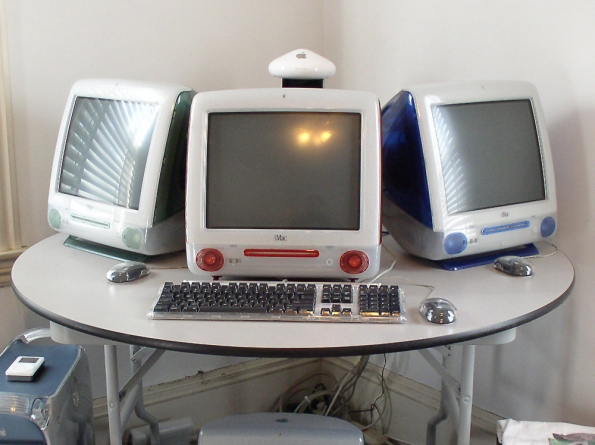
The Apple “Candy” Mac’s made PPC and computing sexy
Apple jumped on the idea. It was the only real alternative to x86. And you have to remember that – had Apple gone to x86 at that point, they would basically have fed the forces that wanted them dead. You could hardly make out where Microsoft started and Intel ended during the early 90s.
I’m going to spare you the whole fall and rebirth of Apple. Needless to say Apple came to the point where their branch of PowerPC processors caused more problems than they had benefits. The type of PowerPC processors Apple used generated an absurd amount of heat, and it was turning into a real problem. We see this in their later models, like the dual cpu G5 PowerMac where 40% of the cabinet is dedicated purely to cooling.
And yes, Commodore kicked the bucket back in 1994 so they never finished their new models. Which is a damn shame because unlike Apple they went with a dedicated RISC processor. These models did not suffer the heating problems the PPC’s used by Apple had to deal with.
Note: PPC and RISC are two sides of the same coin. PPC processors are RISC based, but naturally there exists hundreds of different implementations. To avoid a ton of arguments around this topic I treat PPC as something different from PA-RISC which Commodore was playing with in their Hombre “skunkworks” projects.
You can read all about Apple’s strain of PowePC processors here, and PA-RISC here.
PPC in modern computers?
I am going to be perfectly honest. When I heard that the new Amiga machines were based on PowerPC my reaction was less than polite. I mean who the hell would use PowerPC in our day and age? Surely Apple’s spectacular failure would stand as a warning for all time? I was flabbergasted to say the least.
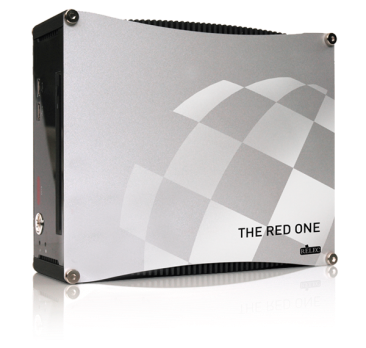 The Amiga One came out and I didn’t even give it the time of day. The Sam440 motherboards came out, I couldn’t care less. It would have been nice to own one, but the price at the time and the lack of software was just to disproportionate to make sense.
The Amiga One came out and I didn’t even give it the time of day. The Sam440 motherboards came out, I couldn’t care less. It would have been nice to own one, but the price at the time and the lack of software was just to disproportionate to make sense.
And now there is the Amiga x5000 and a smaller, more affordable A1222 (a.k.a “Tabour”) model just around the corner. And they are both equipped with a PPC CPU. There are just two logical conclusions you can make when faced with this: either the maker of these products is nuttier than a snicker’s bar, or there is something the general public doesn’t know.
What the general public doesn’t know has turned out to be quite a lot. While you would think PPC was dead and buried, the reality of PPC is not that simple. Turns out there is not just one PPC family (or branch) but several. The one that Apple used back in the day (and that MorphOS for some odd reason support) represents just one branch of the PPC tree if you like. I had no idea this was the case.
The first thing you are going to notice is that the CPU in the new Amiga’s doesn’t have the absurd cooling problems the old Mac’s suffered. There are no 20cm cooling ribs and you don’t need 2 fans on Ritalin to prevent a cpu meltdown; and you also don’t need a custom aluminium case to keep it cool (everyone thinks the “Mac Pro” cases were just to make them look cool. Turned out it was more literal, it was to turn the inside into a fridge).
In other words, the branch of PPC that we have known so far, the one marketed as “PowerPC” by Apple, Phase5 and everyone back in the 90’s is indeed dead and buried. But that was just one branch, one implementation of what is known as PPC.
Remember when ARM died?
When I started to dig into the whole PPC topic I could not help but think about the Arm processor. It’s almost spooky to reflect on how much we, the consumer, blindly accept as fact. Just think about it: You were told that PowerPC was the bomb, so you ended up buying that. Then you were told that PowerPC was crap and that x86 was the bomb, so you mentally buried PowerPC and bought x86 instead. The consumer market is the proverbial cheep farm where most of us just blindly accept whatever advertising tell us.
This was also the case with Arm. Remember a company called Acorn? It was a great british company that invented, among other things, the Arm core. I remember reading articles about Acorn when I was a kid. I even sold my Amiga for a while and messed around with an Acorn Archimedes. A momentary lapse of sanity, I know; I quickly got rid of it and bought back my Amiga. But I did learn a lot from messing around in RISC OS.
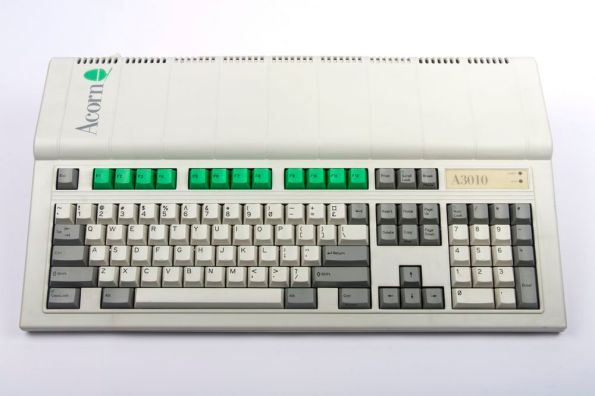
The Acorn Archimedes, a brilliant RISC based machine that sadly didnt make it
My point is, everyone was told that Arm was dead back in the 80’s. The Acorn computers used a pure RISC processor at the time (again, PPC is a RISC based CPU but I treat them as separate since the designs are miles apart), but it was no secret that they were hoping to equip their future Acorn machines with this new and magic Arm thing. And reading about the power and speed of Arm was very exciting indeed. Sadly such a computer never saw the light of day back in the 80’s. Acorn went bust and the market rolled over Acorn much like it would Commodore later.
The point im trying to make is that, everyone was told that Arm died with Acorn. And once that idea was planted in the general public, it became a self-fulfilling prophecy. Arm was dead. End of story. It doesn’t matter that Acorn had set up a separate company that was unaffected by the bankrupcy. Once the public deem something as dead, it just vanish from the face of the earth.
Fast forward to our time and Arm is no longer dead, quite the opposite! It’s presently eating its way into just about every piece of electronics you can think of. In many ways Arm is what made the IOT revolution possible. The whole Raspberry PI phenomenon would quite frankly never have happened without Arm. The low price coupled with the fantastic performance -not to mention that these cpu’s rarely need cooling (unless you overclock the hell out of them) has made Arm the most successful CPU ever made.
The PPC market share
With Arm’s so-called death and re-birth in mind, let’s turn our eyes to PPC and look at where it is today. PPC has suffered pretty much the same fate as Arm once did. Once a branch of the tech is defined “dead” by media and spin-doctors, regardless if the PPC is actually a cluster of designs not a single design or “chip”, the general public blindly follows – and mentally bury the whole subject.
And yes I admit it, I am guilty of this myself. In my mind there was no distinction between PPC and PowerPC. Which is a bit like not knowing the difference between Rock & Roll as a genre, and KISS the rock band. If we look at this through a parallel what we have done is basically to ban all rock bands, regardless of where they are from, because one band once gave a lousy concert.
And that is where we are at. PPC has become invisible in the consumer market, even though it’s there. Which is understandable considering the commercial mechanisms at work here, but is really PPC dead? This should be a simple question. And commercial mechanisms not withstanding the answer is a solid NO. PPC is not dead at all. We have just parked it in a mental limbo. Out of sight, out of mind and all that.

Playstation 3, Nintendo WII U and Playstation VR all use Freescale PPC
PPC today has a strong foothold in industrial computing. The oil sector is one market that use PPC SBC’s extensively (read: single board computers). You will find them in valve controllers, pump and drill systems and pretty much any systems that require a high degree of reliability.
You will also be surprised to learn that cheap PPC SBC’s enjoy the same low energy requirements people adopt Arm over (3.3 – 5.0 V). And naturally, the more powerful the chip – the more juice it needs.
The reason that PPC is popular and still being used with great success is first of all reliability. This reliability is not just physical hardware but also software. PPC gives you two RTOS’s (real-time operating system) to choose from. Each of them comes with a software development toolchain that rivals whatever Visual Studio has to offer. So you get a good-looking IDE, a modern and up to date compiler, the ability to debug “live” on the boards – and also real-time signal processing protocols. The list of software modules you can pick from is massive.
The last part of that paragraph, namely real-time signal processing, is extremely important. Can you imagine having an oil valve with 40.000 cubic tons of pressure failing, but the regulator that is supposed to compensate doesn’t get the signal because Linux or Windows was busy with something else? It get’s pretty nutty at that level.
The second market can be found with set-top boxes, game consoles and tv signal decoders. While this market is no doubt under attack from cheap Arm devices – PPC still has a solid grip here due to their reliability. PPC as an embedded platform has roughly two decades head start over Arm when it comes to software development. That is a lifetime in computing terms.
When developers look at technology for a product they are prototyping, the hardware is just one part of the equation. Being able to easily write software for the platform, perform live debugging of code on the boards, and maintain products over decades rather than consumer based 1-3 year warranties; it’s just a completely different ballgame. Technology like external satellite-dish parts runs for decades without maintenance. And there are good reasons why you dont see x86 or Arm here.

Playstattion 3 and the new PSX VR box both have a Freescale PPC cpu
As mentioned earlier, the PPC branch used today is not the same branch that people remember. I cannot stress this enough, because mixing these is like mistaking Intel for AMD. They may have many of the same features but ultimately they are completely different architectures.
The “PowerPC” label we know from back in the day was used to promote the branch that Apple used. Amiga accelerators also used that line of processors for their PowerUP boards. And anyone who ever stuffed a PowerUP board in their A1200 probably remember the cooling issues. I bought one of the more affordable PowerUP boards for my A1200, and to this day I associate the whole episode as a fiasco. It was haunted by instability, sudden crashes and IO problems – all of it connected to overheating.
But PPC today as delivered by Freescale Semiconductors (bought by NXP back in 2015) are different. They don’t suffer the heat problem of their remote and extinct cousins, have low power requirements and are incredibly reliable. Not to mention leagues more powerful than anything Apple, Phase 5 or Commodore ever got their hands on.
Is Freescale for the Amiga a total blunder?
Had you asked me a few days back chances are I would said yes. I have known for a while that Freescale was used in the oil sector, but I did not take into consideration the strength of the development tools and the important role an RTOS system holds in a critical production environment.
I must also admit that I had no idea that my Playstation and Nintendo consoles were PPC based. Playstation 4 doesn’t use PPC on its motherboard, but if you buy the fantastic and sexy VR add-on package, you get a second module that is again – a PPC based product.
It also turns out that IBM’s high-end mainframes, those Amazon and Microsoft use to build the bedrock for cloud computing are likewise PPC based. So once again we see that PPC is indeed there and it’s playing an important role in our lives – but most people don’t see it. So all of this is a matter of perspective.
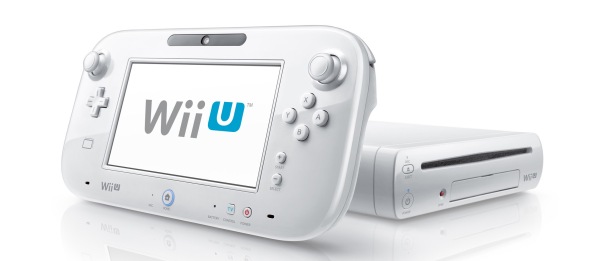
The Nintendo WII U uses a Freescale PPC cpu, not exactly a below-par gaming system
But the Amiga x5000 or A1222 will not be controlling a high-pressure valve or serving half a million users (hopefully); so does this affect the consumer at all? Does any of this hold any value to you or me? What on earth would real-time feedback mean for a hobby user that just want to play some games, watch a movie or code demos?
The answer is: it could have a profound benefit, but it needs to be developed and evolved first.
Musicians could benefit greatly from the superior signal processing features, but as of writing I have yet to find any mention of this in the Amiga NG SDK. So while the potential is there I doubt we will see it before the Amiga has sold in enough volume.
Fast and reliable signal dispatching in the architecture will also have a profound effect on IPC (inter process communication), allowing separate processes to talk with each other faster and more reliably than say, windows or Linux. Programmers typically use a mutex or a critical-section to protect memory while it’s being delivered to another process (note: painting in broad strokes here), this is a very costly mechanism under Windows and Linux. For instance, the reason UAE is still single threaded is because isolating the custom chips in separate threads and having them talk – turned out to be too slow. If PPC is able to deal with that faster, it also means that processes would communicate faster and more interesting software can be made. Even practical things like a web-server would greatly benefit from real-time message dispatching.
So for us consumers, it all boils down to volume. The Freescale branch of PPC processors is not dead and will be around for years to come; they are sold by the millions every year to great variety of businesses; and while most of them operate outside the traditional consumer awareness, it does have a positive effect on pricing. The more a processor is sold the cheaper it becomes.
Most people feel that the Amiga x5000 is to expensive for a home computer and they blame that on the CPU. Forgetting that 50% of the sub total goes into making the motherboard and all the parts around the CPU. The CPU alone does not represent the price of a whole new platform. And that’s just the hardware! On top of this you have the job of re-writing a whole operating system from scratch, add features that have evolved between 1994 and 2017, and make it all sing together through custom written drivers.
So it’s not your average programming project to say the least.
But is it really too expensive? Perhaps. I bought an iMac 2 years back that was supposed to be my work machine. I work as a developer and use VMWare for almost all my coding. Turned out the i5 based beauty just didn’t have the ram. And fitting it with more ram (it came with 16 gigabytes, I need at least 32) would cost a lot more than a low-end PC. The sad part is that had I gone for a PC I could have treated myself to an i7 with 32 gigabyte ram for the same price.
I later bit the bullet and bought a 3500€ Intel i7 monster with 64 gigabytes of ram and the latest Nvidia graphics card. Let’s just say that the Amiga x5000 is reasonable in context with this. I basically have an iMac i have no use for, it just sits there collecting dust and is reduced to a music player.
Secondly we have to look at potential. The Mac and Windows machines now have their potential completely exposed. We know what these machines do and it’s not going to change any time soon.
The Amiga has a lot of hidden potential that has yet to be realized. The signal processing is just one of them. The most interesting is by far the Xena chip (XMOS) that allow developers to implement custom hardware in software. It might sound like FPGA but XMOS is a different technology. Here you write code using a custom C compiler that generates a special brand of opcodes. Your code is loaded onto a part of the chip (the chip is divided into X number of squares, each representing a piece of logic, or “custom chip” if you like) and will then act as a custom-chip.
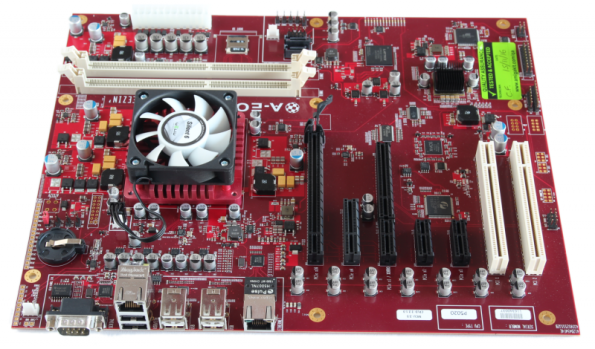
The Amiga x5000 in all her glory, notice the moderate cooling for the CPU
The XENA technology could really do wonders for the Amiga. Instead of relying on traditional library files that are executed by the main CPU, things like video decoding, graphical effecs, auxiliary 3D functionality and even emulation (!) can now be dealt-with by XENA and executed in parallel with the main CPU.
If anything is going to make or break the Amiga, it wont be the Freescale PPC processor – it will be the XENA chip and how they use it to benefit the consumer.
Just imagine running UAE almost solely on the XENA chip, emulating 68k applications at near native speed – without using the main CPU at all? Sounds pretty good! And this is a feature you wont find on a PC motherboard. Like always they will add it should it become popular, but right now it’s not even on the radar.
So I for one do believe that the next generation Amiga machines have a shot. The A1222 is probably going to be the defining factor. It will retail at an affordable price (around 450€) and will no doubt go head-to-head with both consoles and mid-range PC’s.
So like always it’s about volume, timing and infrastructure. Everything but the actual processor to be honest.
Last words
Its been a valuable experience to look around and read up on PPC. When I started my little investigation I had a dark picture in my head where the new Amiga machines were just a waste of time. I am happy to say that this is not true and the Freescale processors are indeed alive and kicking.
It was also interesting to see how widespread PPC technology really is. It’s not just a specialist platform, although that is absolutely where it’s strength is financially; it ships in everything from your home router to your tv-signal decoder or game system. So it does have a foot in the consumer market, but like I have outlined here – most consumers have parked it in a blind-spot and we associate the word “PowerPC” with the fiasco of Apple in the past. Which is a bit sad because it’s neither true or fair.
I have no problem seeing a future where the Amiga becomes a viable commercial product again. I think there is some way to go before that happens, and the spear-head is going to be the A1222 or a similar product.
But like I have underlined again and again – it all boils down to developers. A platform is only as good as the software you can run on it, and Hyperion should really throw themselves into porting games and creativity software. They need to build up critical mass and ship the A1222 with a ton of titles.
For my personal needs I will be more than happy just owning the x5000. It doesn’t need to be a massive commercial success, because Amiga is in my blood and I will always enjoy using it. And yes it is a bit expensive and I’m not in the habit of buying machines like this left and right. But I can safely say that this is a machine that I will be enjoying for many, many years into the future – regardless of what others may feel about it.
I would suggest that Hyperion lower their prices to somewhere around 1000€ if possible. Right now they need to think volume rather than profit, and hopefully Hyperion will start making the OS compatible with Arm. Again my thoughts go to volume and that IOT and embedded systems need an alternative to Linux and Windows 10 embedded.
But right now I’m itching to start developing for it – and I’m not alone 🙂
Amiga OS 4, object pascal and everything
Those that read my blog knows that I’m a huge fan of the Commodore Amiga machines. This was a line of computers that took the world by storm around 1985 and held its ground until 1993. Sadly the company had to file for bankruptcy after a series of absurd financial escapades by its management.

The original team before it fell prey to mismanagement
The death of Commodore is one of the great tragedies in computing history. There is no doubt that Commodore represented a much-needed alternative to Microsoft and Apple – and the death of Commodore meant innovation of technology took a turn for the worse.
Large books have been written on this subject, as well as great documentaries and movies – so I’m not going to dig further into the drama here. Ars Technica has a range of articles covering the whole story, so if you want to understand how the market got the way it is today, head over and read up on the story.
On a personal level I find the classic Amiga machines a source of great inspiration even now. Despite Commodore dying in the 90’s, today 30 years after the fact I still stumble over amazing source-code on this awesome computer; There are a few things in Amiga OS that “hint” to its true age, but ultimately the system has aged with amazing elegance and grace. It just blows people away when they realize that the Amiga desktop hit the market in 1984 – and much of what we regard as a modern desktop experience is actually inherited from the Amiga.

Amiga OS is highly customizable. Here showing OS 3.9 [the last of the classic OS versions]
For instance: the realization of the new Amiga models have cost £ 1.2 million, so there are serious players involved in this.
The user-base is varied of course, it’s not all developers and engineers. You have gamers who love to kick back with some high quality retro-gaming. You have graphics designers who pixel large masterpieces (an almost lost art in this day and age). And you have musicians who write awesome tracks; then use that to spice up otherwise flat and dull PC based tracks.
What is even more awesome is the coding. Even the latest Freepascal has been ported, so if you were expecting people hand punching hex-codes you will be disappointed. While the Amiga is old in technical terms, it was so far ahead of the competition that people are surprised just how capable the classic systems are.
And yes, people code games, demos and utility programs for the classical Amiga systems even today. I just installed a Dropbox cloud driver on my system and it works brilliantly.
The brand new Amiga
Classic Amiga machines are awesome, but this post is not about the old models; it’s about the new models that are coming out now. Yes, you read right: next generation Amiga computers that have finally become a reality. Having waited for 22 years I am thrilled to say that I just ordered a brand new Amiga 5000! (and cant wait to install Freepascal and start coding).
It’s also quite affordable. The x5000 model (which is the power system) retails at around €1650, which is roughly half the price I paid for my Intel i7, Nvidia GeForce GTX 970 workstation. And the potential as a developer is enormous.
Just think about the onslaught of Delphi code I can port over, and how instrumental my software can become by getting in early. Say what you will about Freepascal but it tends to be the second compiler to hit a platform after GCC. And with Freepascal in place a Delphi developer can do some serious magic!
 Right. So the first Amiga is the power model, the Amiga 5000. This can be ordered today. It cost the same as a good PC (1600€ range depending on import tax and vat). This is far less than I paid for my crap iMac (that I never use anymore).
Right. So the first Amiga is the power model, the Amiga 5000. This can be ordered today. It cost the same as a good PC (1600€ range depending on import tax and vat). This is far less than I paid for my crap iMac (that I never use anymore).
The power model is best suited for people who do professional work on the machine. Software development doesn’t necessarily need all the firepower the x5000 brings, but more demanding tasks like 3d rendering or media composition will.
The next model is the A1222 which is due out around x-mas 2017 /slash/ first quarter

The A1222 “Tabour”
2018. You would perhaps expect a mid-range model, something retailing at around €800 or there abouts – but the A1222 is without a doubt a low-end model.
It should retail for roughly €450. I think this is a great idea because AEON (who makes hardware) have different needs from Hyperion (who makes the new Amiga OS [more about that further into the article]). AEON needs to get enough units out to secure the foundation – while Hyperion needs vertical market penetration (read: become popular and also hit other hardware platforms as well). These factors are mutually exclusive, just like they are for Windows and OS X. Which is probably why Apple refuse to sell OS X without a mac, or they could end up competing with themselves.
A brave new Amiga OS
But there is more to this “revival” than just hardware. Many would even say that hardware is the least interesting about the next generation systems, and that the true value at this point in time is the new and sexy operating system. Because what the world needs now more than hardware (in my opinion) is a lightweight alternative to Linux and Windows. A lean, powerful, easy to use, highly customizable operating system that will happily boot on a $35 Raspberry PI 3b, or a $2500 Intel i7 monster. Something that makes computing fun, affordable and most of all: portable!
And with lean I have to stress that the original Amiga operating system, the classic 3.x system that was developed all the way to the end – was initially created to thrive in as little as 512kb. At most I had 2 megabytes of ram in my Amiga 1200 and that was ample space to write and run large programs, play the latest games and enjoy the rich, colorful and user-friendly desktop environment. We have to remember that Amiga had a multi-tasking, window based OS a decade before Microsoft.
Naturally the next-generation systems is built to deal with the realities of 2017 and beyond, but incredibly enough the OS will run just fine with as little as 256 megabytes. Not even Windows embedded can boot up on that. Linux comes close with distributions like Puppy and DSL, but Amiga OS 4 gives you a lot more functionality out of the box.
What way to go?
OK so we have new hardware, but what about the software? Are the new Amiga’s supposed to run some ancient version of Amiga OS? Of-course not! The people behind the new hardware have teamed up with a second company, Hyperion, that has believe it or not, done a full re-implementation of Amiga OS! And naturally they have taken the opportunity to get rid of annoying behavior – and adding behavior people expect in 2017 (like double-clicking on a window header to maximize it, easy access to menus and much more). Visually Amiga OS 4 is absolutely gorgeous. Just stunning to look at.
Now there are many different theories and ideas about where a new Amiga should go. Sadly it’s not just as simple as “hey let’s make a new amiga“; the old system is literally boiled in patent and legislation issues. It is close to an investors worst nightmare since ownership is so fragmented. Back when Commodore died, different parts of the Amiga was sold to different companies and individuals. The main reason we havent seen a new Amiga until now – is because the owners have been fighting between themselves. The Amiga as we know it has been caught in limbo for close to two decades.
My stance on the whole subject is that Trevor Dickenson, the man behind the next generation Amiga systems, has done the only reasonable thing a sane human being can when faced with a proverbial patent kebab: the old hardware is magical for us that grew up on it – but by todays standard they are obsolete dinosaurs. The same can be said about the Amiga OS 3.9. So Trevor has gone for a full re-implementation and hardware.
The other predominant idea is more GNU/Linux in spirit, where people want Amiga OS to be platform independent (or at least written in a way that makes the code run on different hardware as long as some fundamental infrastructure exists). This actually resulted in a whole new OS being written, namely Aros, which is a community made Amiga OS clone. A project that has been perpetually maintained for 20 years now.
While I think the guys behind Aros should be applauded, I do feel that AEON and Hyperion have produced something better. There are still kinks to work out on both systems – and don’t get me wrong: I am thrilled that Aros is available, I just enjoy OS 4 more than I do Aros. Which is my subjective opinion of course.
New markets
Right. With all this in mind, let us completely disregard the old Amiga, the commodore drama and instead focus on the new operatingsystem as a product. It doesn’t take long before a few thrilling opportunities present themselves.
The first that comes to my mind is how well suited OS 4 would be as an embedded platform. The problem with Linux is ultimately the same that haunts OS X and Windows, namely that size and complexity grows proportionally over time. I have seen Linux systems as small as 20 megabytes, but for running X based full screen applications, taking advantage of hardware accelerated graphics – you really need a bigger infrastructure. And the moment you start adding those packages – Linux puts on weight and dependencies fast!

The embedded market is one place where Amiga OS would do wonders
With embedded systems im not just talking about head-less servers or single application devices. Take something simple like a ticket booth, an information kiosk or POS terminal. Most of these run either Windows embedded or some variation of Linux. Since both of these systems require a fair bit of infrastructure to function properly, the price of the hardware typically start at around 300€. Delphi and C++ based solutions, at least those that I have seen, end up using boards in the 300€ to $400€ range.
This price-tag is high considering the tasks you need to do in a POS terminal or ticket system. You usually have a touch enabled screen, a network connection, a local database that will cache information should the network be down – the rest is visual code for dealing with menus, options, identification and fault tolerance. If a visa terminal is included then a USB driver must also be factored in.
These tasks are not heavy in themselves. So in theory a smaller system if properly adapted for it could do the same if not better job – at a much better price.
More for less, the Amiga legacy
Amiga OS would be able to deliver the exact same experience as Windows and Linux – but running on more cost-effective hardware. Where modern Windows and Linux typically need at least 2 gigabyte of ram for a heavy-duty visual application, full network stack and database services – Amiga OS is happy to run in as little as 512 megabytes. Everything is relative of course, but running a heavy visual application with less than a gigabyte memory in 2017 is rare to say the least.
Already we have cut cost. Power ARM boards ships with 4 gigabytes of ram, powered by a snappy ARM v9 cpu – and medium boards ship with 1 or 2 gigabytes of ram and a less powerful cpu. The price difference is already a good 75€ on ram alone. And if the CPU is a step down, from ARM v9 to ARM v8, we can push it down by a good 120€. At least if you are ordering in bulk (say 100 units).
The exciting part is ultimately how well Amiga OS 4 scales. I have yet to try this since I don’t have access to the machine I have ordered yet – and sadly Amiga OS 4.1 is compiled purely for PPC. This might sound odd since everyone is moving to ARM, but there is still plenty of embedded systems based on PPC. But yes, I would urge our good friend Trevor Dickenson to establish a migration plan to ARM because it would kill two birds with one stone: upgrading the faithful Amiga community while entering into the embedded market at the same time. Since the same hardware is involved these two factors would stimulate the growth and adoption of the OS.

The PPC platform gives you a lot of bang-for-the-buck in the A1222 model
But for sake of argument let’s say that Amiga OS 4 scales exceptionally well, meaning that it will happily run on ARM v8 with 1 gigabyte of ram. This would mean that it would run on systems like the Asus Tinkerboard that retails at 60€ inc. vat. This would naturally not be a high performance system like the A5000, but embedded is not about that – it’s about finding something that can run your application safely, efficiently and without problems.
So if the OS scales gracefully for ARM, we have brought the cost down from 300€ to 60€ for the hardware (I would round that up to 100€, something always comes up). If the customers software was Windows-based, a further 50€ can be subtracted from the software budget for bulk licensing. Again buying in bulk is the key.
Think different means different
Already I can hear my friends that are into Linux yell that this is rubbish and that Linux can be scaled down from 8 gigabytes to 20 megabytes if so needed. And yes that is true. But what my learned friends forget is that Linux is a PITA to work with if you havent spent a considerable amount of time learning it. It’s not a system you can just jump into and expect to have results the next day. Amiga OS has a much more friendly architecture and things that are often hard to do on Windows and Linux, is usually very simple to achieve on the Amiga.
Another fact my friends tend to forget is that the great majority of commercial embedded projects – are done using commercial software. Microsoft actually presented a paper on this when they released their IOT support package for the Raspberry PI. And based on personal experience I have to agree with this. In the past 20 years I have only seen 2 companies that use Linux as their primary OS both in products and in their offices. Everyone else uses Windows embedded for their products and day-to-day management.
So what you get are developers using traditional Windows development tools like Visual Studio or Delphi (although that is changing rapidly with node.js). And they might be outstanding programmers but Linux is still reserved for server administrators and the odd few that use it on hobby basis. We simply don’t have time to dig into esoteric “man pages” or explore the intricate secrets of the kernel.
The end result is that companies go with what they know. They get Windows embedded and use an expensive x86 board. So where they could have paid 100€ for a smaller SBC and used Amiga OS to deliver the exact same product — they are stuck with a 350€ baseline.
Be the change
The point of this little post has been to demonstrate that yes, the embedded market is more than open for alternatives. Linux is excellent for those that have the time to learn its many odd peculiarities, but over the past 20 years it has grown into a resource hungry beast. Which is ironic because it used to be Windows that was the bloated scapegoat. And to be honest Windows embedded is a joy to work with and much easier to shape to your exact needs – but the prices are ridicules and it wont perform well unless you throw at least 2 gigabyte on it (relative to the task of course, but in broad strokes that’s the ticket).
But wouldn’t it be nice with a clean, resource friendly and extremely fast alternative? One where auto-starting applications in exclusive mode was a “one liner” in the startup-sequence file? A file which is actually called “startup-sequence” rather than some esoteric “init.d” alias that is neither a folder or an archive but something reminiscent of the Windows registry? A system where libraries and the whole folder structure that makes up drivers, shell, desktop and service is intuitively named for what they are?

Amiga OS could piggyback on the wave of low-cost ARM SBC’s that are flooding the market
You could learn how to use Amiga OS in 2 days tops; but it holds great depth so that you can grow with the system as your needs become more complex. But the general “how to” can be picked up in a couple of days. The architecture is so well-organized that even if you know nothing about settings, a folder named “prefs” doesn’t leave much room for misinterpretation.
But the best thing about AmigaOS is by far how elegant it has been architected. You know, when software is planned right it tends to refactor out things that would otherwise be an obstacle. It’s like a well oiled machinery where each part makes perfect sense and you don’t need a huge book to understand it.
From where I am standing, Amiga OS is ultimately the biggest asset the Hyperion and AEON have to offer. I love the new hardware that is coming out – but there is no doubt in my mind, and I know I am right about this, that the market these companies should focus on now is not PPC – but rather ARM and embedded systems.
It would take an effort to port over the code from a PPC architecture to ARM, but having said that – PPC and ARM have much more in common than say, PPC and x86.
I also think the time is ripe for a solid power ARM board for desktop computers. While smaller boards gets most of the attention, like the Raspberry PI, the ODroid XU4 and the (S)Tinkerboard – once you move the baseline beyond 300€ you see some serious muscle. Boards like iMX6 OpenRex SBC Ultra packs a serious punch, and like expected it ships with 4 gigabyte of ram out of the box.
While it’s impossible to do a raw comparison between the A1222 and the iMX6 OpenRex, I would be surprised if the iMX6 delivered terrible performance compared to the A1222 chipset. I am also sure that if we beefed up the price to 700€, aimed at home computing rather than embedded – the ARM power boards involved would wipe the floor with PPC. There are a ton of factors at play here – a fast CPU doesn’t necessarily mean better graphics. A good GPU should make up at least 1/5 of the price.
Another cool factor regarding ARM is that the bios gives you a great deal of features you can incorporate into your product. All the ARM board I have gives you FAT32 support out of the box for instance, this is supported by the SoC itself and you don’t need to write filesystem drivers for it. Most boards also support Ext2 and Ext3 filesystems. This is recognized automatically on boot. The rich bios/mini kernel is what makes ARM so attractive to code for, because it takes away a lot of the boring, low-level tasks that took months to get right in the past.
Final words
This has been a long article, from the early years of Commodore – all the way up to the present day and beyond. I hope some of my ideas make sense – and I also hope that those who are involved in the making of the new Amiga perhaps pick up an idea or two from this material.
Either way I will support the Amiga with everything I got – but we need a couple of smart ideas and concrete plans on behalf of management. And in my view, Trevor is doing exactly what is needed.
While we can debate the choice of PPC, it’s ultimately a story with a long, long background to it. But thankfully nothing is carved in stone and the future of the Amiga 5000 and 1222 looks bright! I am literally counting the days until I get one!
Smart Pascal: Support for next generation Amiga A1222
If you are between 35 and 45 years old, chances are you remember the Commodore Amiga. This was the major computer to have back in the 80’s and 90’s. And if you know your history you also know that it was way ahead of all the other systems out there. Microsoft prides itself on inventing multi-tasking, but truth is that Amiga OS had a full multitasking, window oriented desktop way back in 1984.
Before you think this post is about the old computers, let me just say that it’s not; I realize that most of you will immediately think retro when you hear the word Amiga – but fact is that Amiga is doing somewhat of a comeback these days.
A brand new operating system
AmigaOS was awesome for its time and really was a system from the future. In an age where the average PC was a monochrome green dos experience, and Mac’s were ridicules black and white boxes – the Amiga was like something out of a spaceship. PC’s didn’t even have a mouse, let alone any form of multimedia – and here was a powerhouse of a machine that had a full windowing desktop, bright and crisp colors, co-processors dedicated to graphics, sound and dispatching — people had never seen anything like it.
Sadly, due to some borderline insane management decisions, Commodore went bankrupt back in 1994. You would think that the Amiga just went away after that, but it’s still going to this day. Two decades after Commodore went out of business – people still write software for the platform and some of the coolest hardware you will ever see is released for it every year. It really is an astounding computer and community. I mean, only recently in 2016 at least 5 new games were released for the platform (!)
Needless to say, the old operating system that culminated in OS 3.9 is hopelessly trapped in the past. Which is why the people who bought the rights to the system have spent more than a few years bringing it up to speed (right now it’s at version 4.1). And the result speaks for itself. It really is one of the best looking desktop systems in the world.
Brand new hardware
Say what you want about Amiga hardware but the quality was outstanding. But outstanding hardware from the early 90’s can’t hope to compete with modern computers. We are used to GPU chips that spin millions of pixels around the screen per second without breaking a sweat; 24 bit sound, monstrous 3d graphics processors, multi threading, gigabytes of ram and terabytes of storage space (phew!).
With Commodore long dead and no company officially in charge of hardware, a man called Trevor Dickinson decided that he had enough. Back in the day everyone was waiting for Commodore to release the Amiga 5000 (the Amiga 4000 was the Commodore flagship back in the 90s, sadly that was the end of it), including Trevor. This dream of the next Amiga is something everyone that loved the platform share even to this day. Well, Trevor decided to do something about the situation. He picked up the gauntlet, sharpened his sword and his journey towards a new Amiga began.
Without going into too much nitty-gritty here, Trevor and his colleagues set out to create a PPC based motherboard capable of running Amiga OS 4. And yes, the operating system is presently PPC based. This is due to the fact that in the 90’s both the Amiga and Apple Mac’s used the MC68k line of processors. These were retired and replaced with PPC chips. This made perfect sense at the time. Since Apple used them in their computers – the Amiga could enjoy cheaper hardware and piggyback on Apples success.
Most people today think that PPC is an obsolete chipset, but fact is that they are still in production – largely so, because they are popular for embedded systems. The obscene problems with heating is no longer as pressing at it used to be due to changes in production and materials – and as a consequence the new Amiga uses PPC even now.
I have two monster PPC based Mac’s in my basement so I was a bit timid when I heard that OS 4.x was using PPC. I mean the top of the line powermac is more cooling metal than content. But thankfully that line of PPC chips is a thing of the past.
Two exciting models
There have been a ton of Commodore related attempts to get the Amiga back on the market, every five years or so someone buys the Commodore name and tries to revive the glory days of the Amiga (or so it seems). All of them have failed largely due to internal fighting between the many owners that has rights to various bits and pieces. If there is a reason that the Amiga never managed to get back into market – this is it. The rights to various parts of the system was auctioned off to the highest bidder, with the operating system going one way, chips going another and name and intellectual property. It has been a complete cluster fuck since that horrible day back in 1994.
Trevor on the other hand has solved this the only way a reasonable and sane human being can. Which is to simply abandon and leave the old hardware, the Commodore name and the old machines peculiarities where they belong; In the past. So what if you can’t slap Commodore on the physical machine? The new Amiga was not designed to be a 30 year old computer. It was designed from scratch to run Amiga OS 4 and to be a system based on the same principles as the original; And that is (at least to me) what really counts. I enjoyed the old games and demo scene, but the desktop and programming aspects of the Amiga was always where my heart was.
Besides, kids that grew up in the aftermath of Commodore going under – don’t have a clue what the Amiga was anyhow. Nor do they have any relationship to Commodore as a brand. And considering 20 years have passed -clinging to these old names is ultimately a complete waste of time and money. So Trevor’s being fed up and deciding to build a whole new machine for the updated and modernized Amiga operating system – that makes perfect sense to me.
Unlike previous attempts by various individuals and groups, Trevor’s work is more tangible. In fact, you can go out right now and order the high-end PPC based monster that is the Amiga x5000. This is the most expensive model and it’s going to set you back a whopping €1800. This may seem like a steep price but bear in mind the amount of work and cost of parts – so it’s actually not that bad.
As a modern developer my computer needs have grown exponentially every year. I no longer install my development tools on my actual PC, instead I use VMWare and have all my development platforms neatly organized as virtual machines. The result is that I can no longer buy the cheap or middle-range offerings. My latest PC cost me around €2500. So all things considered €1800 is in the same range as an Amiga 4000 went for back in the day. This is a work horse that professionals use, it’s not a low-end gaming model.

The A1222 “Tabour” motherboard is a cheaper, more affordable entry machine. This is the one I’m getting to start with
Thankfully there is a cheaper model in the pipeline. I have already pre-ordered the A1222 which retails at around 400€ (give or take vat and shipping). This has a smaller CPU, less ram (you can of course stuff more in yourself) and you have to get your own mini-atx cabinet for it. As the name hints to this is equivalent to a bog standard A1200, which was my all time favorite. My old gem of a machine had a 40 megabyte harddisk, 4 megabytes of ram and an external CS-ROM. These specs are ridicules today, even my phone has more .. well, everything really; but 20 years ago that setup was the bomb.
When people talk retro like I do now, always remember that the Amiga operating system was able to deliver a close to Windows 95 experience. That should tell you something about how fast, well written and efficient the old Amiga was.
This was a machine that delivered an impressive and modern desktop experience even by today’s standards in 512 Kb (yes you read that right, kilobytes) of working ram. Imagine what an OS based on the same principles can do with 4 gigabytes of ram, 32 bit graphics, protected and paged memory, 24 bit audio and all the perks of modern computing.
Where emulation can’t go
Those that follow my blog know that I Amiga emulation and retro computing. So whenever I have time I whip out my Raspberry PI 3b based Amiga and enjoy my Amiga games, desktop and even do a spot of programming. We even managed to get Freepascal 3.x to compile on it, which means I can write applications with all the cool features of modern object-oriented programming at my disposal. On an Amiga 4000 emulated – the mind boggles when you think about this to long.

Here showing my retro-fitted A500 PI with sexy led keyboard, overclocked to the hilt running at 4 times the speed of an original Amiga 4000 (for $35!)
Sadly you can forget running Amiga OS 4 under emulation on the PI. Sure, it works fine on Windows or Linux – but emulation is only as good as the code emulating it. And while the PPC emulation layer is a monumental achievement and I applaud the original author, it’s not nearly as optimized as the older 68k layer. From what I know it’s still running ad-hoc with no JIT involved (or at least not cache’d). This means that you need a powerful PC to really enjoy Amiga OS 4. Emulation is a bit like bootleg movies, and a poor bootleg will ruin the movie completely. You can get away with a mid-range x86 PC I suppose, but you can forget about ARM or x86 embedded boards.
Perhaps you remember that I tested various embedded boards a while back? Part of my motivation in doing that (and buying HW for €300 on a whim) was to find a reasonably priced x86 or ARM single board computer that could emulate OS 4 without problems. The most expensive and capable of the boards I tested was the UP x86 board that retails at around $150 (I got the biggest model they had on offer). And yes, it did manage to run Amiga OS 4, just not in a way that made it usable or enjoyable. On my kick ass Intel i7 based PC it emulates just fine, but again – it becomes ridicules not buying a real Amiga since emulation will cost me more or the same. I mean, why not go for the real deal if its affordable?
So if a €400 Amiga is what it takes to run OS 4 properly, then I have no problem supporting Trevor’s work and get the real deal.
Freepascal and Smart
While Trevor doesn’t know me personally, I am a huge fan of his endeavour. And one of the things I want to start porting to the shiny new OS 4.x platform is of course – Smart Pascal. If you have ever heard of Turbo Pascal and Delphi (with emphasis on the latter) then you get some idea of what Smart is. Except that we compile for node.js and the browser rather than machine-code.
So before I can port that over I will have to get Chromium run on OS 4, and then link that up with Freepascal. I do enjoy C++ but its not even close to the productivity of object pascal so I prefer to work in that. And since freepascal 3.x has thankfully been ported already that is not a problem. So with a bit of work I think Delphi developers will be in for a treat, and people new to programming will love learning object pascal.

Porting the full might of Smart Mobile Studio to the Amiga is going to take an effort, but I think it will be worth it
But naturally, not everyone is used to building from the ground up. It will take some work and probably weeks of adaptation before the full might of Smart Mobile Studio runs on the Amiga. But when it does – it will have a huge impact. Because then you can use the Amiga to create cloud servers, mobile applications for ALL platforms and much, much more!
So if being a part of using an operating system from the grass-root and up sounds exciting, why not take a peek at the A1222 or Amiga x5000?
Head over to http://www.a-eon.com/ and have a gander


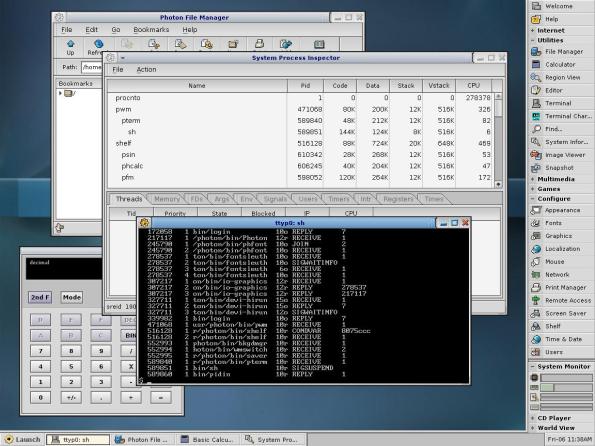
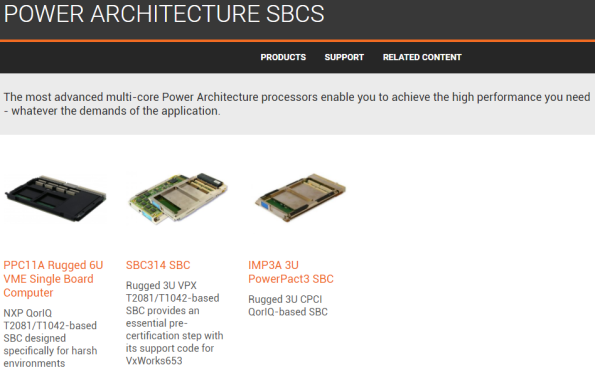
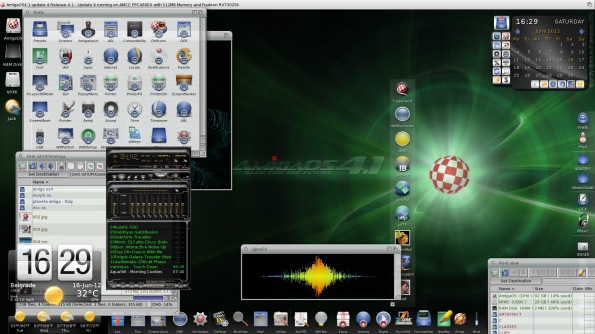


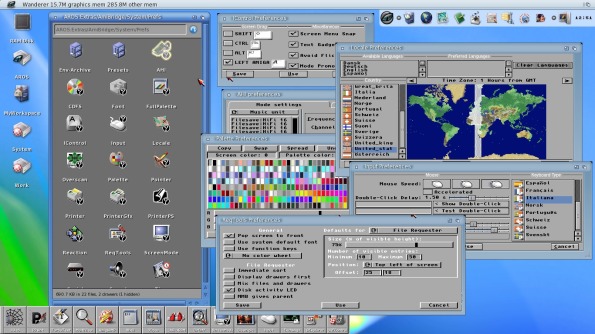
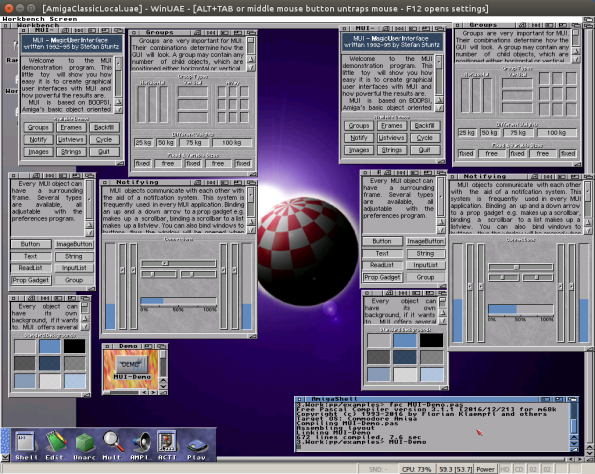
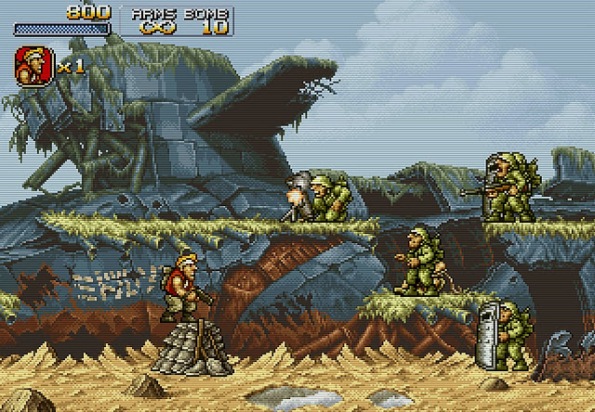






You must be logged in to post a comment.